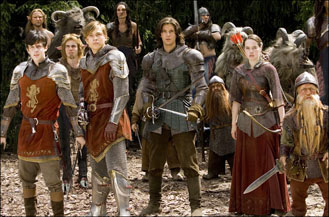|
|
Chapter Two: Prince CaspianBy Brett BeachJuly 22, 2009
But inherent in Lewis' first two Narnia novels is an absence that the films can't quite grapple with: the fact that the children have already grown old here once before, at the end of The Lion, the Witch and the Wardrobe, before making their way home and resuming their original ages, and have now returned from England a year older from their first adventures, whereas 1,300 years have passed in Narnia. This passage of time is the crux of the story, but it is never really dealt with. The return appearances of Aslan and the White Witch provide some much-needed heft. An image of the faun Tumnus is glimpsed rendered on a wall. Links to the past abound, but since the focus is on Prince Caspian this time around (his name is in the title), the Pevensies seem like window dressing in the continuation of their own adventures. The script deals with this by making the battle sequences the star of the film and it works, up to a point. But the attachment to the characters (and the actors portraying them) isn't there like it is with the Harry Potter series, for example. The one performer truly allowed to shine by virtue of having a well-written role and an original take on how to play it is Peter Dinklage and his embodiment of the dwarf Trumpkin. Standing every cliché about dwarves, trolls,and the like on their collective heads, he has a gravitas, a wit and a wounded sense of self-worth all boiled together that make him the greatest special effect in the film most of the running time.
|

|
|
|

|
Monday, April 29, 2024
© 2024 Box Office Prophets, a division of One Of Us, Inc.


